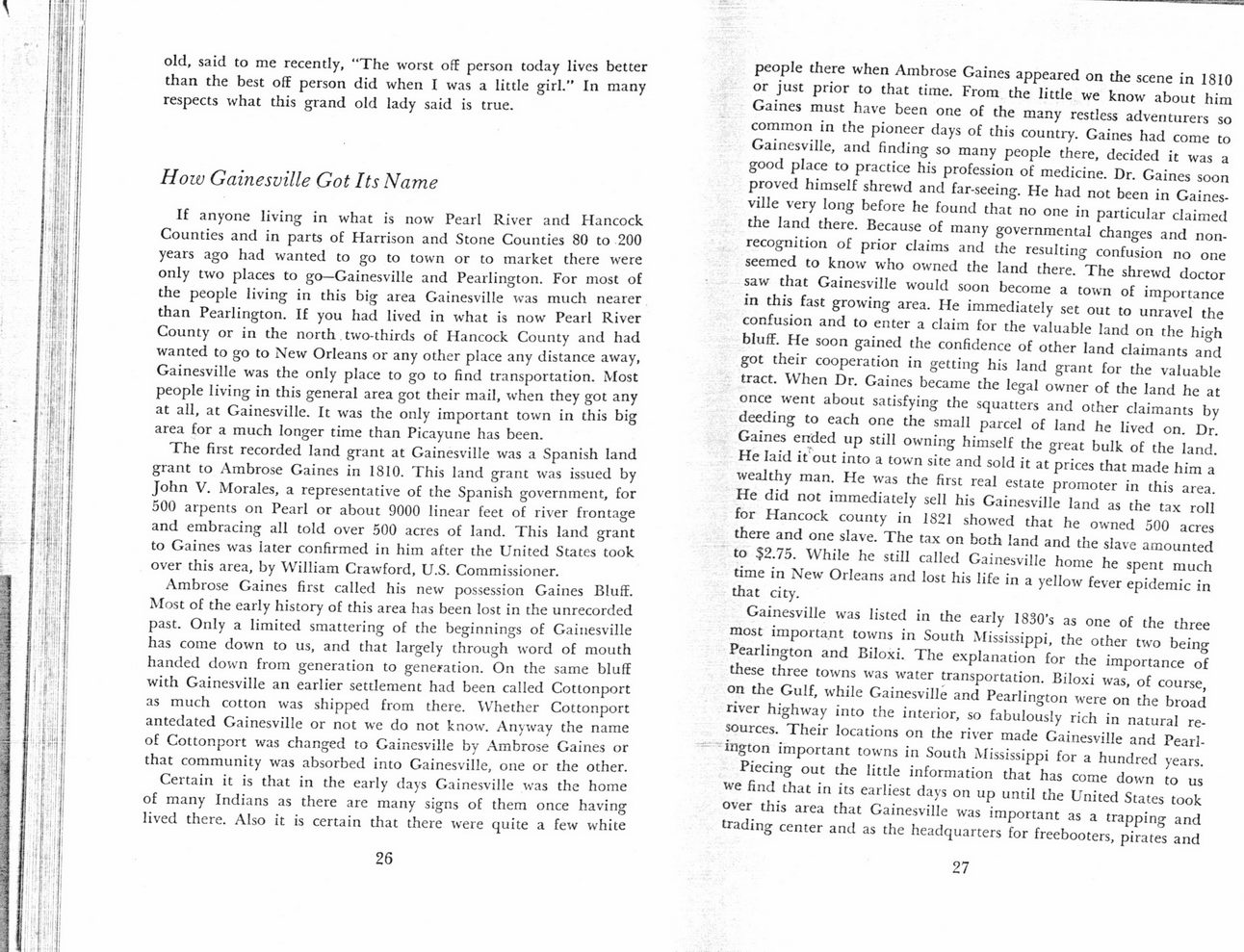This text was obtained via automated optical character recognition.
It has not been edited and may therefore contain several errors.
old, said to me recently, ?The worst off person today lives better than the best off person did when I was a little girl.? In many respects what this grand old lady said is true. How Gainesville Got Its Name If anyone living in what is now Pearl River and Hancock Counties and in parts of Harrison and Stone Counties 80 to 200 years ago had wanted to go to town or to market there were only two places to go?Gainesville and Pearlington. For most of the people living in this big area Gainesville was much nearer than Pearlington. If you had lived in what is now Pearl River County or in the north two-thirds of Hancock County and had wanted to go to New Orleans or any other place any distance away, Gainesville was the only place to go to find transportation. Most people living in this general area got their mail, when they got any at all, at Gainesville. It was the only important town in this big area for a much longer time than Picayune has been. The first recorded land grant at Gainesville was a Spanish land grant to Ambrose Gaines in 1810. This land grant was issued by John V. Morales, a representative of the Spanish government, for 500 arpents on Pearl or about 9000 linear feet of river frontage and embracing all told over 500 acres of land. This land grant to Gaines was later confirmed in him after the United States took over this area, by William Crawford, U.S. Commissioner. Ambrose Gaines first called his new possession Gaines Bluff. Most of the early history of this area has been lost in the unrecorded past. Only a limited smattering of the beginnings of Gainesville has come down to us, and that largely through word of mouth handed down from generation to generation. On the same bluff with Gainesville an earlier settlement had been called Cottonport as much cotton was shipped from there. Whether Cottonport antedated Gainesville or not we do not know. Anyway the name of Cottonport was changed to Gainesville by Ambrose Gaines or that community was absorbed into Gainesville, one or the other. Certain it is that in the early days Gainesville was the home of many Indians as there are many signs of them once having lived there. Also it is certain that there were quite a few white 26 people there when Ambrose Gaines appeared on the scene in 1810 or just prior to that time. From the little we know about him Gaines must have been one of the many restless adventurers so common in the pioneer days of this country. Gaines had come to Gainesville, and finding so many people there, decided it was a good place to practice his profession of medicine. Dr. Gaines soon proved himself shrewd and far-seeing. He had not been in Gainesville very long before he found that no one in particular claimed the land there. Because of many governmental changes and nonrecognition of prior claims and the resulting confusion no one seemed to know who owned the land there. The shrewd doctor saw that Gainesville would soon become a town of importance in this fast growing area. He immediately set out to unravel the confusion and to enter a claim for the valuable land on the high bluff. He soon gained the confidence of other land claimants and got their cooperation in getting his land grant for the valuable tract. When Dr. Gaines became the legal owner of the land he at once went about satisfying the squatters and other claimants by deeding to each one the small parcel of land he lived on. Dr. Gaines ended up still owning himself the great bulk of the land. He laid it out into a town site and sold it at prices that made him a wealthy man. He was the first real estate promoter in this area. He did not immediately sell his Gainesville land as the tax roll for Hancock county in 1821 showed that he owned 500 acres there and one slave. The tax on both land and the slave amounted to $2.75. While he still called Gainesville home he spent much time in New Orleans and lost his life in a yellow fever epidemic in that city. Gainesville was listed in the early 1830?s as one of the three most important towns in South Mississippi, the other two being Pearlington and Biloxi. The explanation for the importance of these three towns was water transportation. Biloxi was, of course, on the Gulf, while Gainesville and Pearlington were on the broad river highway into the interior, so fabulously rich in natural resources. Their locations on the river made Gainesville and Pearlington important towns in South Mississippi for a hundred years. Piecing out the little information that has come down to us we find that in its earliest days on up until the United States took over this area that Gainesville was important as a trapping and trading center and as the headquarters for freebooters, pirates and 27

Pearl Rivers Thigpen Daytrip in 1829-3